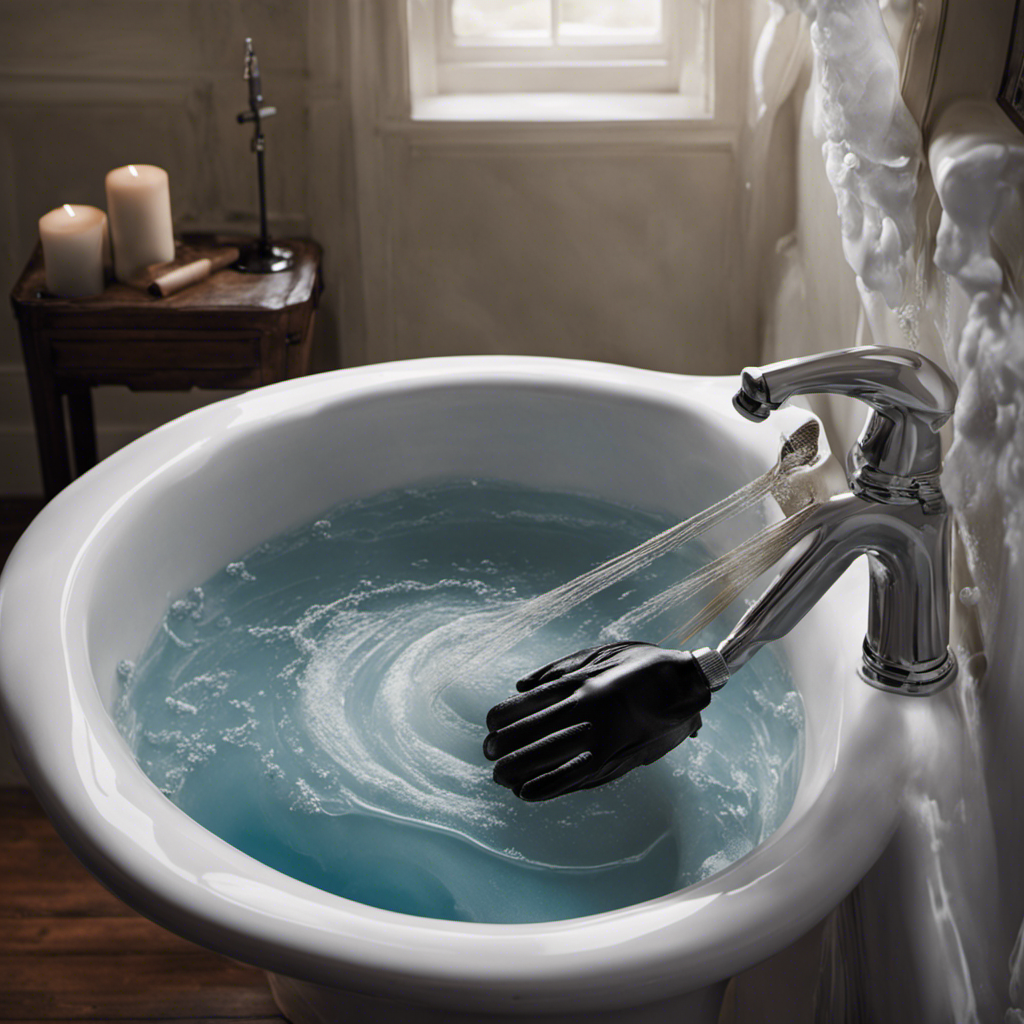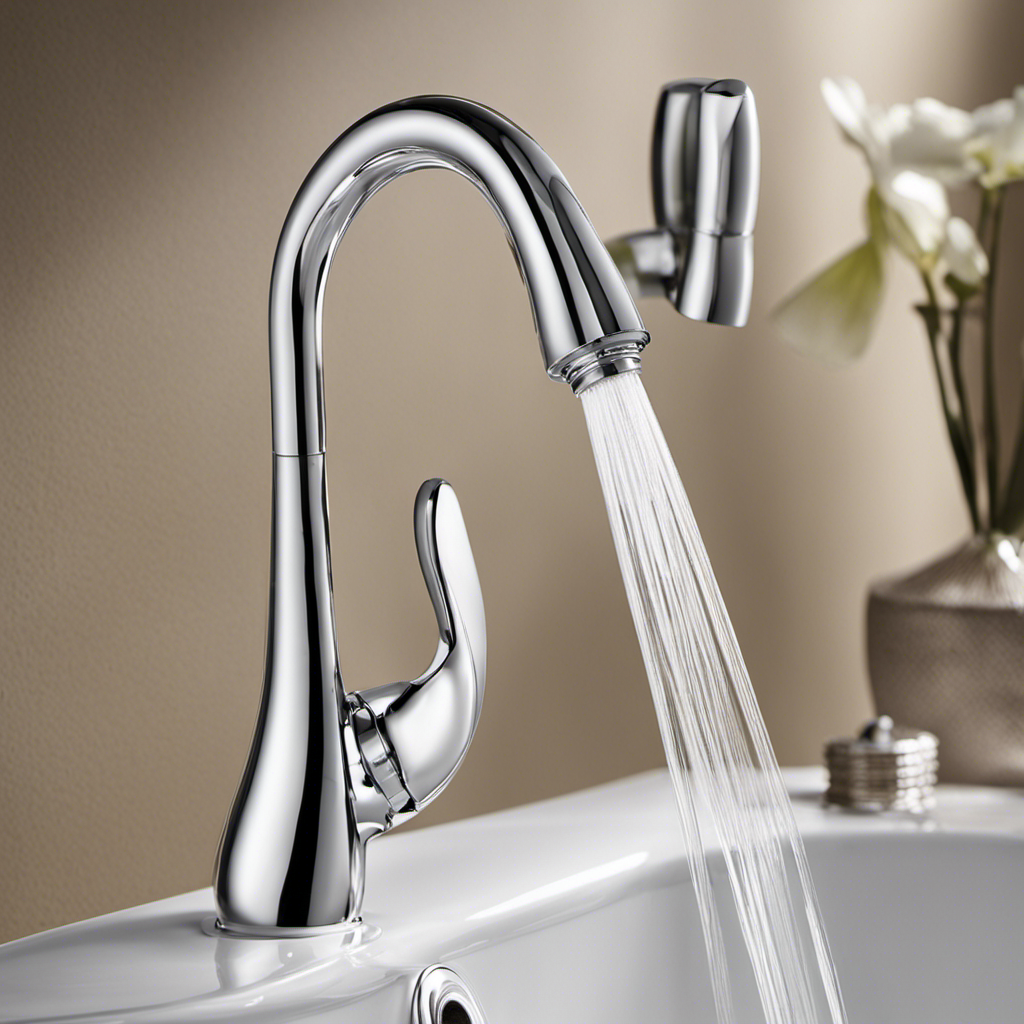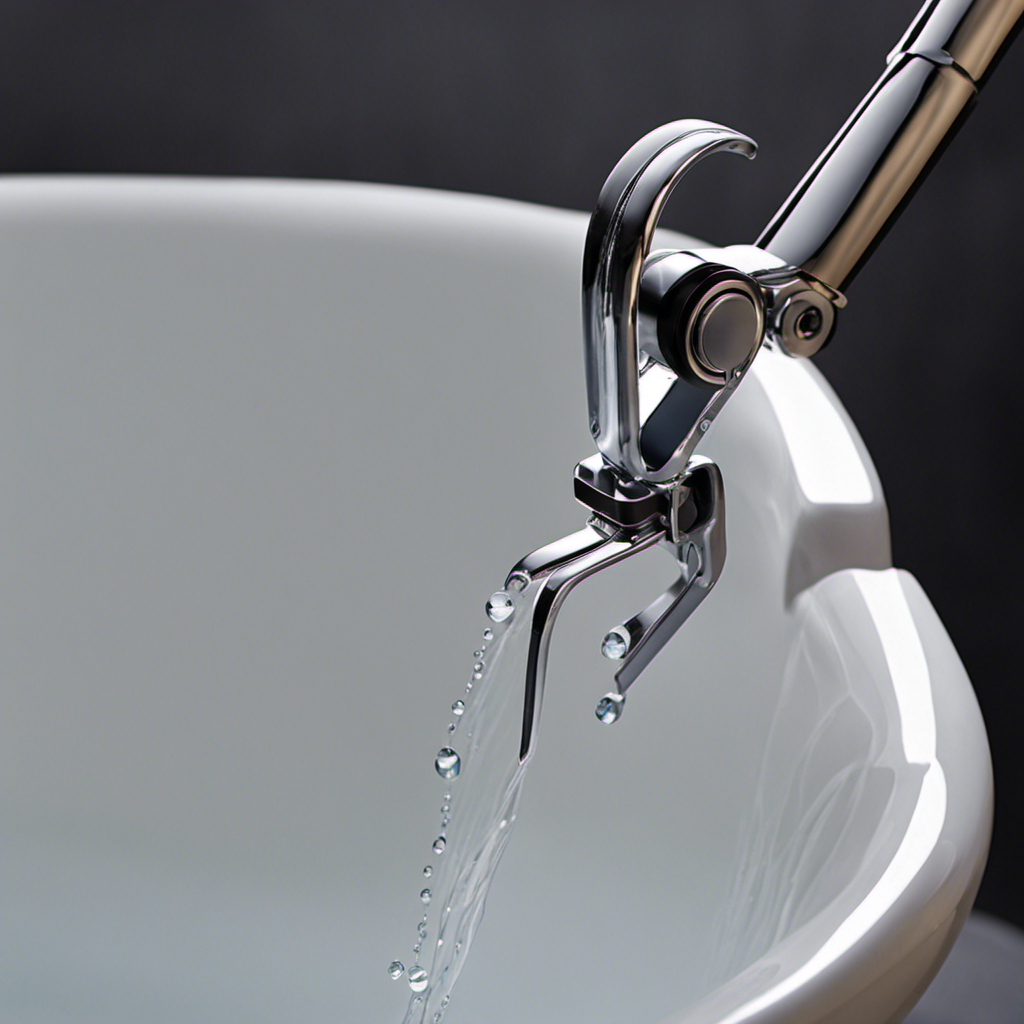I’ve been there before. Standing ankle-deep in water, frustrated by a clogged drain in my bathtub.
But fear not, because I’ve learned a few tricks along the way. In this step-by-step guide, I’ll walk you through the process of unclogging your drain.
From understanding the inner workings of your drainage system to using natural methods and mechanical solutions, we’ll tackle even the most stubborn clogs.
Get ready to reclaim your clear, flowing bathtub with these tried-and-true techniques.
Key Takeaways
- The primary causes of clogged bathtub drains are hair, soap scum, mineral buildup, and foreign objects.
- Slow drainage indicates hair buildup, standing water is caused by soap scum, and gurgling sounds indicate mineral deposits.
- Essential tools for unclogging a bathtub drain include a plunger and a drain snake or auger.
- Natural methods like using vinegar, baking soda, and salt can effectively unclog drains, while mechanical solutions like plungers and drain snakes are useful for stubborn clogs.
Understanding the Drainage System in Your Bathtub
Understanding the drainage system in your bathtub is essential for effectively unclogging it.
To start, let’s take a look at the anatomy of a bathtub drain. The drain consists of a metal or plastic stopper, which is controlled by a lever or knob. Beneath the stopper, there is a curved pipe called the P-trap, which is designed to prevent sewer gases from entering your bathroom.
Now, let’s talk about the common causes of bathtub drain clogs. Hair is the primary culprit, as it easily gets trapped in the drain and forms clumps over time. Soap scum and mineral buildup can also contribute to clogs. Additionally, foreign objects like toys or jewelry accidentally dropped into the drain can cause blockages.
Understanding these factors will help you identify and tackle the problem when it arises.
Identifying the Cause of the Clog
Take a moment to figure out what might be causing the clog in your bathtub. There are several common causes of drain clogs, and identifying the cause is the first step in successfully unclogging your bathtub drain. Here are some signs of a clogged bathtub drain and their potential causes:
| Sign of Clogged Bathtub Drain | Potential Cause |
|---|---|
| Slow drainage | Hair buildup |
| Standing water | Soap scum |
| Gurgling sounds | Mineral deposits |
If you notice slow drainage, it could be due to hair buildup in the drain. Hair tends to accumulate over time and can create a blockage. Standing water is often caused by soap scum, which can build up on the walls of the pipes. Lastly, gurgling sounds can indicate mineral deposits in the pipes, which restrict the flow of water. Once you’ve identified the cause of the clog, you can move on to gathering the necessary tools and materials to unclog your drain.
Gathering the Necessary Tools and Materials
When it comes to unclogging a drain, having the right tools is essential for success.
In order to tackle this task effectively, you will need a few key items.
One of the most important tools is a plunger, which can help create the necessary pressure to dislodge the clog.
Additionally, a drain snake or auger can be helpful for reaching deeper into the pipe and removing stubborn clogs.
Essential Tools for Unclogging
To unclog your bathtub drain, you’ll need a plunger and a drain snake. Here’s a step-by-step guide on how to use these tools effectively:
-
Plunger:
Start by covering the overflow drain with a wet cloth or tape to create a seal. Then, place the plunger over the drain and push down firmly. Pull up quickly, creating suction to dislodge the clog. Repeat this process several times until the water starts to drain. -
Drain Snake:
If the plunger doesn’t work, it’s time to use a drain snake. Insert the snake into the drain and turn the handle clockwise to catch the clog. Once you feel resistance, slowly pull out the snake, removing the clog in the process. Be careful not to damage the pipes. -
Additional Options:
If the clog persists, you may consider using unclogging chemicals or seeking professional plumber assistance.
Materials Needed for Success
You’ll need a plunger and a drain snake to successfully clear the clog in your bathtub. If you don’t have these tools, don’t worry! There are still ways to unclog your drain without them.
One method is by using a mixture of baking soda and vinegar. Start by pouring half a cup of baking soda down the drain, followed by half a cup of vinegar. Let it sit for about 30 minutes, then pour hot water down the drain to flush it out.
Another option is to use boiling water. Simply boil water in a kettle or on the stove and carefully pour it down the drain. Repeat this process a few times to help break up the clog.
If these methods don’t work, you may need to consider professional drain cleaning services. These experts have specialized tools and techniques to effectively clear even the toughest clogs.
Using Natural Methods to Unclog Your Drain
Using natural methods, you can easily unclog your drain in the bathtub. Here’s a simple step-by-step guide:
-
Vinegar and Baking Soda Method:
- Start by pouring half a cup of baking soda down the drain.
- Follow it up with one cup of vinegar.
- Let the mixture sit for about 30 minutes.
- Finally, flush the drain with hot water.
-
Hot Water and Salt Technique:
- Boil a pot of water.
- Pour half a cup of salt down the drain.
- Slowly pour the boiling water into the drain.
- Repeat if necessary.
-
Prevention Tips:
- Use a drain stopper to catch hair and debris.
- Regularly clean your drain by pouring boiling water down it.
- Avoid pouring grease or oil down the drain.
Employing Mechanical Solutions for Stubborn Clogs
When it comes to tackling stubborn clogs in my bathtub, I have found that using a plunger is often the first step to take. To effectively use a plunger, I make sure to cover the overflow drain with a wet cloth and create a tight seal around the drain with the plunger. I then vigorously plunge up and down several times to create suction and dislodge the clog.
If the plunger doesn’t do the trick, I move on to using a drain snake, which is a flexible tool with a coiled wire that can reach deep into the drain to break up the clog. I carefully insert the drain snake into the drain and rotate it while pushing it further in, ensuring that I am breaking up any blockages along the way.
Lastly, if both the plunger and drain snake fail to clear the clog, I turn to using a wet/dry vacuum. I attach the vacuum hose to the drain and create a tight seal. By turning on the vacuum, I am able to create suction and hopefully pull out the clog.
Plunger for Bathtub Clogs
To clear bathtub clogs, grab a plunger and position it over the drain. Here’s how to use a plunger effectively:
-
Create a tight seal: Ensure the plunger completely covers the drain opening. Press it down firmly to create a seal.
-
Apply pressure: Push down on the plunger, then pull up forcefully. Repeat this motion several times to dislodge the clog.
-
Test the drain: After plunging, run water to check if the clog is cleared. If the water drains smoothly, the clog is likely resolved.
Bathtub clogs can be caused by various factors, such as hair accumulation, soap residue, or foreign objects. However, if a plunger doesn’t work, there are alternative methods you can try, such as using a drain snake or a homemade mixture of baking soda and vinegar.
Drain Snake Effectiveness
If you’re dealing with a stubborn clog, try using a drain snake to effectively remove the blockage. A drain snake is a flexible tool that can reach deep into the pipes and break up or pull out the debris causing the clog.
However, if you don’t have a drain snake on hand, there are a few alternatives you can try. One option is to use a wire coat hanger. Straighten it out and create a small hook at one end to grab the clog.
Another alternative is to use a plunger. Just make sure to cover the overflow drain with a wet cloth or tape it shut before plunging.
These DIY drain unclogging methods can be effective, but if they don’t work, you may need to consider using a wet/dry vacuum to suck out the clog.
Using a Wet/Dry Vacuum
Using a wet/dry vacuum is an efficient way for you to remove stubborn clogs in your pipes. Here’s a step-by-step guide on how to use a vacuum cleaner for DIY drain unclogging:
-
Prepare the vacuum: Make sure your wet/dry vacuum is clean and empty. Attach the appropriate attachment for your drain size.
-
Create a seal: Place the vacuum nozzle over the drain opening, ensuring a tight seal. You can use a wet cloth or duct tape to secure it if needed.
-
Start the vacuum: Turn on the vacuum and let it create suction. The strong suction will help dislodge the clog and pull it up into the vacuum.
Remember, using a wet/dry vacuum is most effective for smaller clogs. If the clog is too large or stubborn, it’s best to call a professional plumber.
Stay safe and happy unclogging!
Preventing Future Drain Clogs in Your Bathtub
One way to prevent future drain clogs in your bathtub is by using a hair strainer. This simple tool can help catch hair and other debris before they enter the drain, keeping it clear and maintaining drainage efficiency.
Here’s how to use a hair strainer in your bathtub:
-
Start by removing any existing debris from the drain.
-
Place the hair strainer over the drain opening, ensuring a snug fit.
-
Test the strainer by running water through the drain. Adjust if necessary to ensure proper drainage.
-
After each use, remove the hair strainer and clean out any trapped hair or debris.
-
Regularly check the strainer for signs of wear or damage, and replace if needed.
Conclusion
As I stood there, staring at my now unclogged bathtub drain, I couldn’t help but feel a sense of accomplishment. It was as if the unclogged drain symbolized a weight being lifted off my shoulders, a burden finally released.
The step-by-step process I followed, armed with my tools and materials, allowed me to conquer the stubborn clog that had plagued me for days. And now, with the knowledge I’ve gained, I can confidently prevent future drain clogs.
So go forth, my friends, and conquer your drain troubles with determination and a little bit of symbolism.










